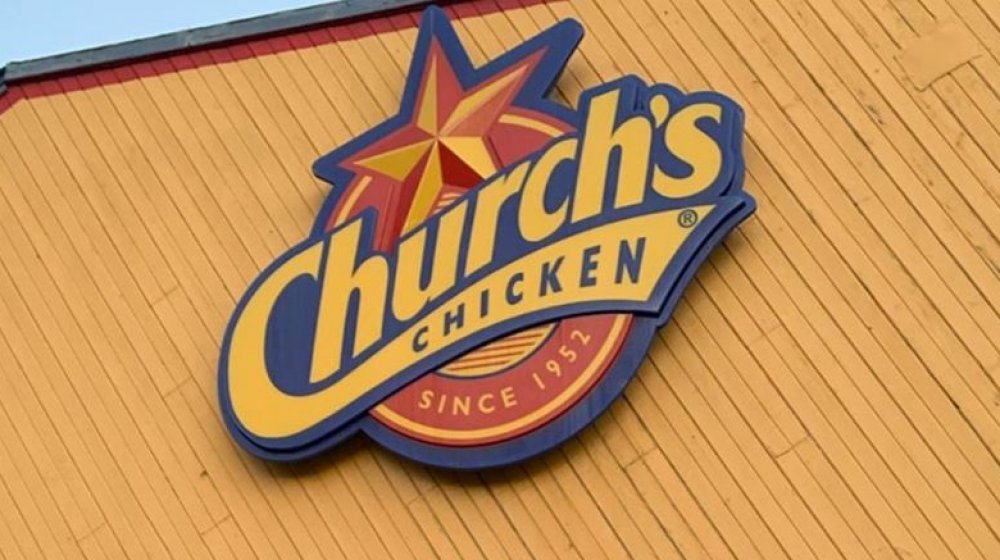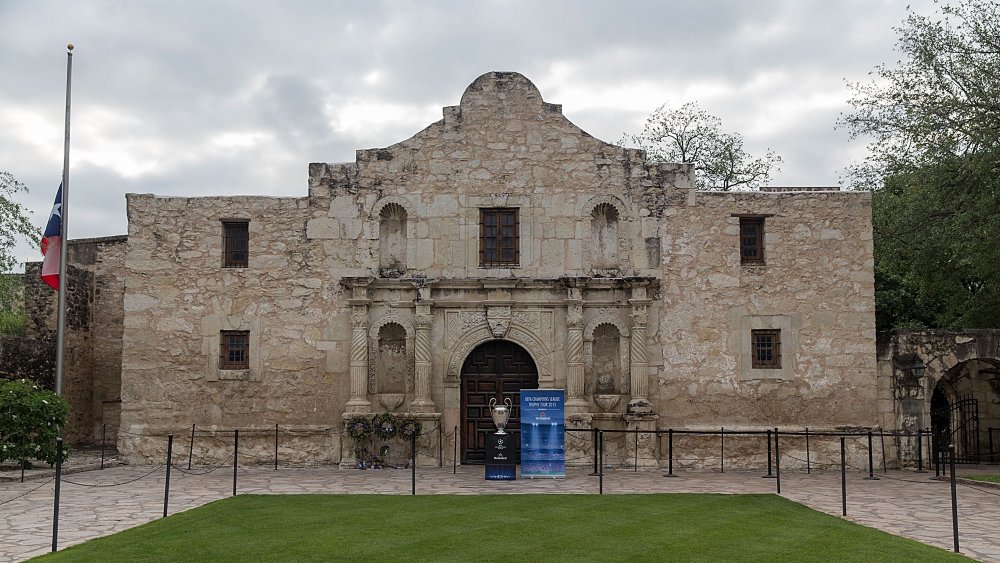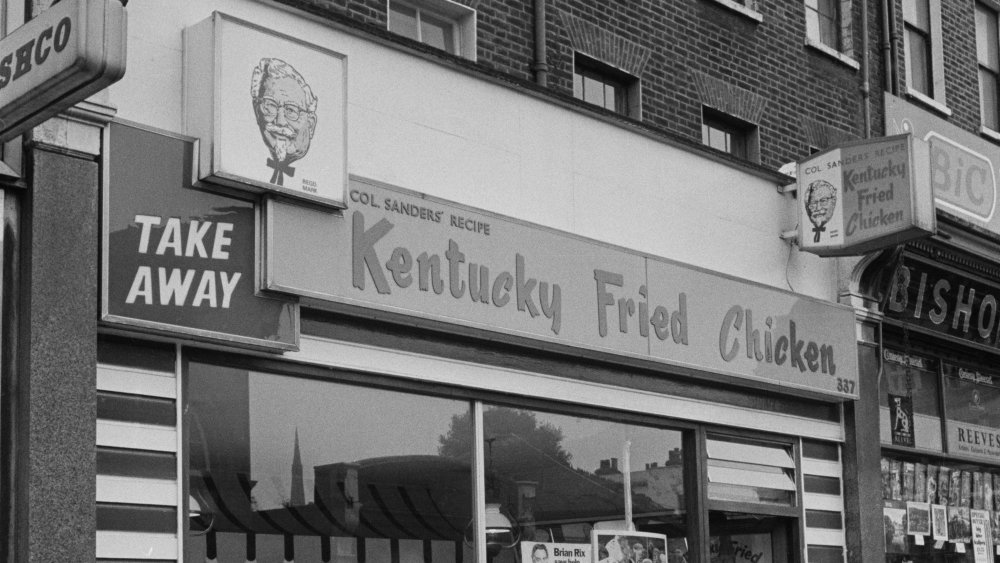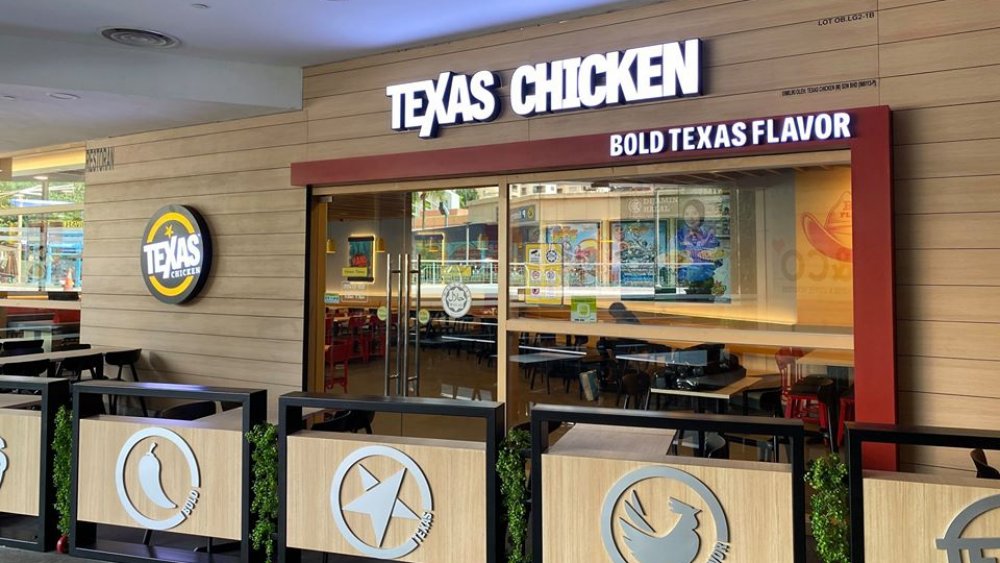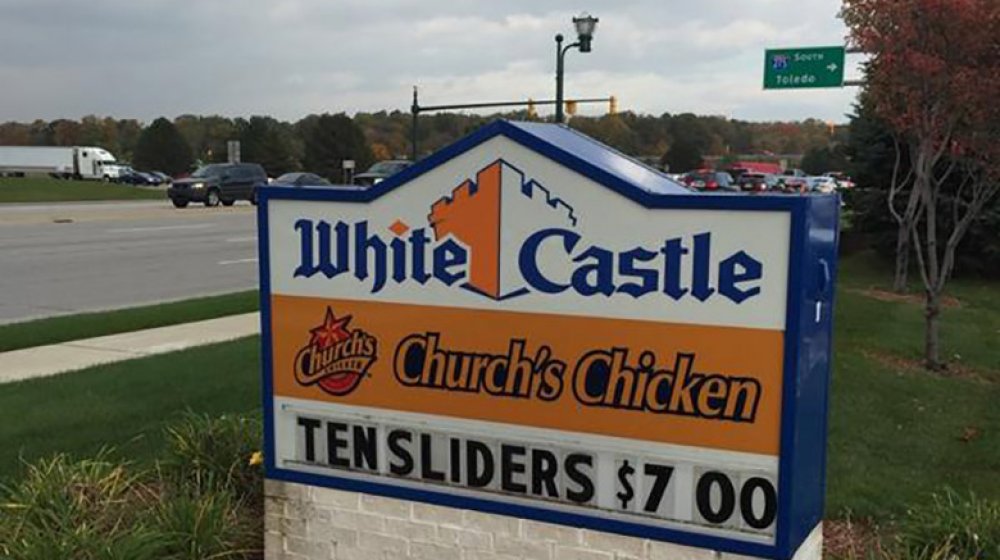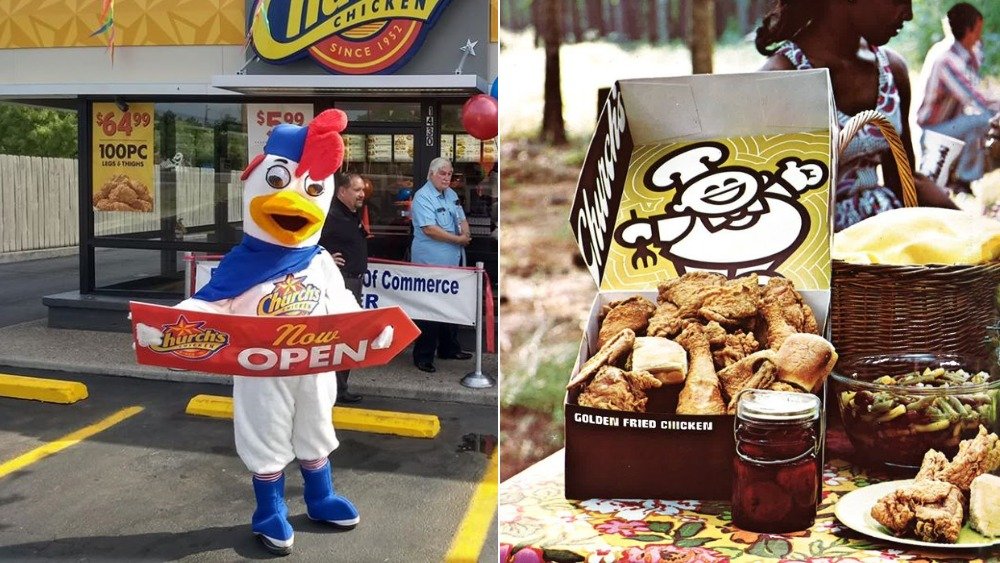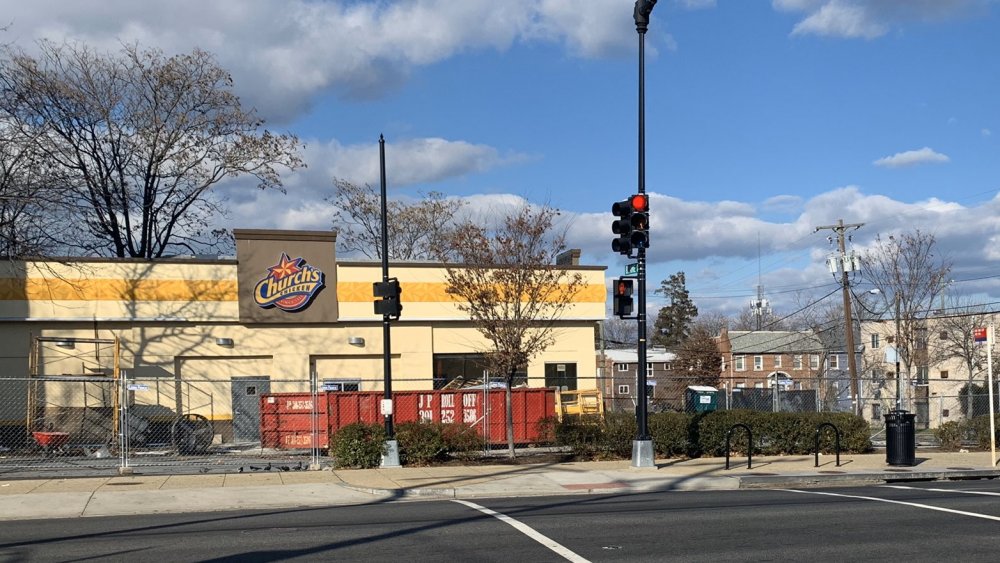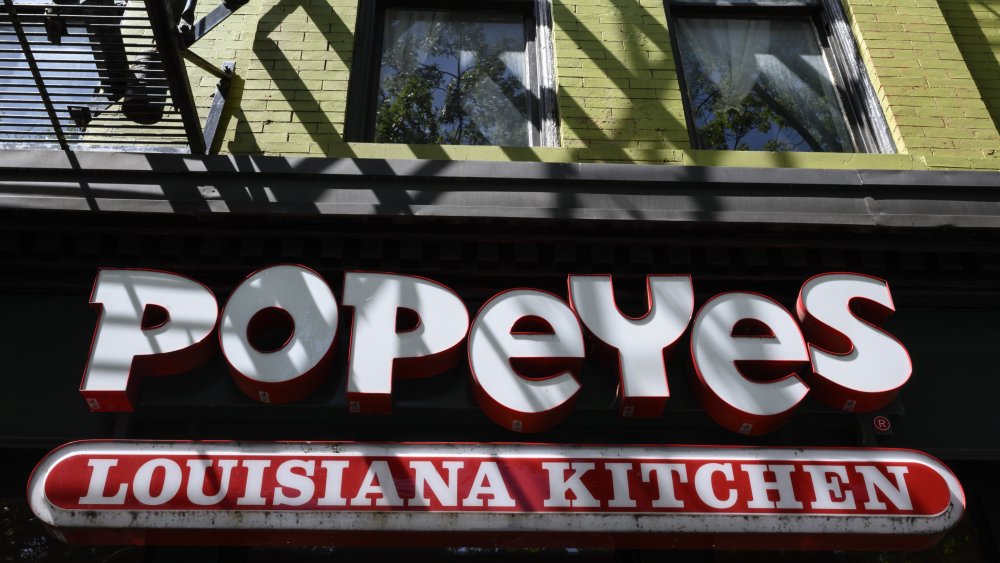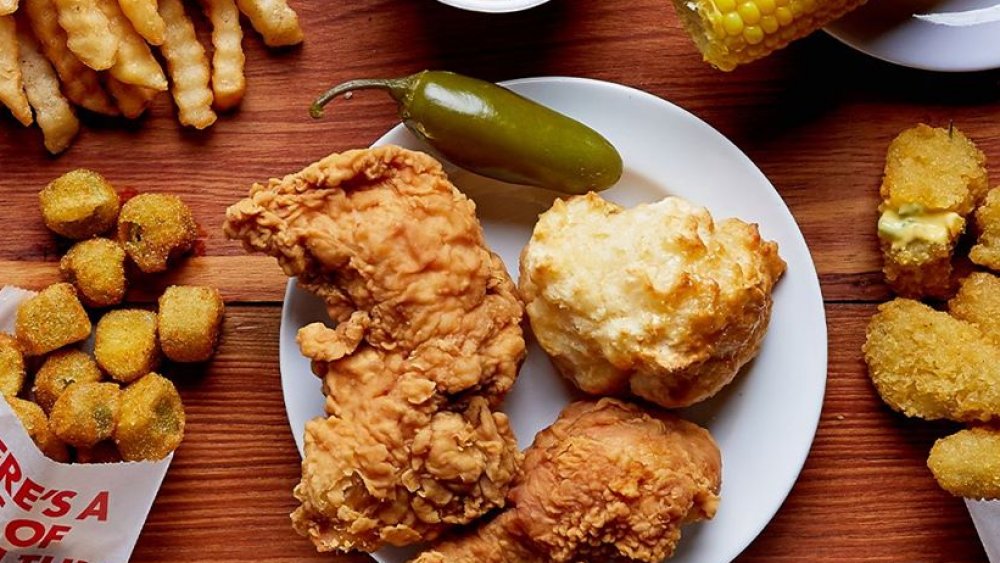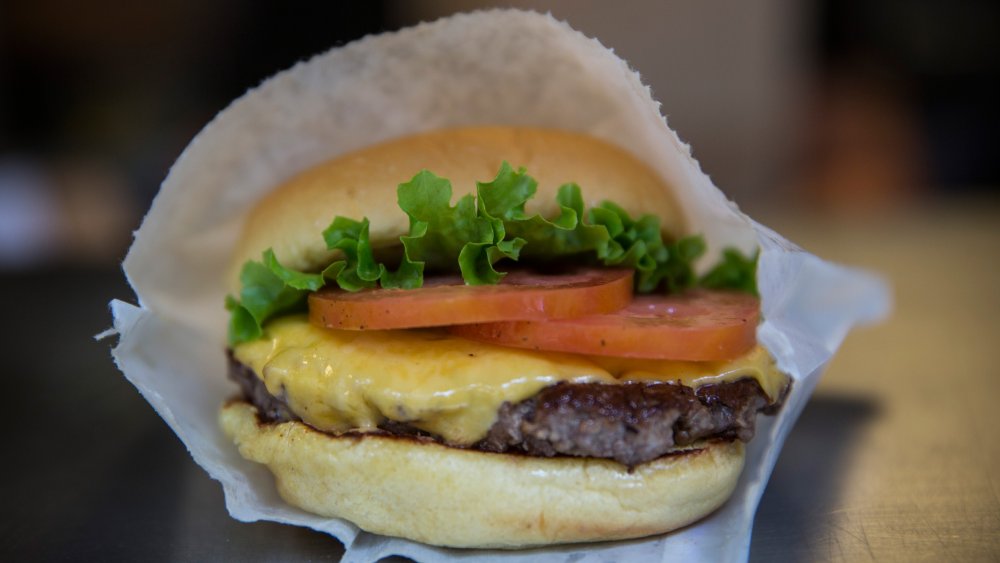The Untold Truth Of Church's Chicken
Burgers and fries might be what first comes to mind when most people think of fast food, but fried chicken is likely a close second. There's no shortage of fast food chicken chains in the United States and more seem to be popping up all the time. Church's Chicken might not have a history as long as KFC or be as popular as Chick-fil-A, but it's been a fast food staple for decades.
While many of the offerings at Church's Chicken are comparable to their competitors — biscuits, mashed potatoes, family meals — they've managed to create a devoted fan base and expand not just from coast to coast in the U.S., but around the world. According to My San Antonio, Church's Chicken has grown from its humble Texas beginnings to include some 1,660 locations scattered throughout 30 countries around the globe.
From their early beginnings in the heart of Texas to popular side items and troubling urban myths, this is the story of Church's Chicken.
The first Church's Chicken was located across the street from an American landmark
Whataburger might be the favorite hamburger of the Lone Star State, but Church's is king in Texas when it comes to chicken. Church's also has the upper hand (or wing in this case) over Whataburger when it comes to Texas history. The famous chicken chain was founded across the street from an American landmark that played a vital part in the history of Texas. We're talking, of course, about the Alamo.
According to My San Antonio, the restaurant's founder, George W. Church, opened the first Church's Chicken in Alamo Plaza in 1952. The first restaurant didn't even have a dining room and patrons would walk right up to the window where they could get two pieces of fried chicken and a roll for just 49 cents. The restaurant wasn't much more than a small shack, but it obviously made an impact on San Antonians, and in just 10 years, Church's had expanded to eight locations in the city.
Church's Chicken expanded into neighborhoods KFC wasn't interested in
When it comes to fast food chicken, KFC is the big bird that everyone else looks to follow. At least they used to be, Chick-fil-A seems to be winning the chicken battle these days (via USA Today). Anyway, back to KFC... By the 1960s, there were 600 Kentucky Fried Chicken locations scattered throughout the United States (via Associated Press). If the little guy was to get ahead, they'd have to outsmart Colonel Sanders and that's exactly what Church's Chicken did.
According to San Antonio Express-News, while Kentucky Fried Chicken may have been building a fried chicken empire across the USA, they were pretty picky about where they put their new restaurants. KFC wasn't opening locations up in low-income urban neighborhoods. This is where Church's Chicken saw an opportunity and the growing restaurant business began moving into neighborhoods that KFC wasn't interested in.
This would prove to be a successful expansion plan for Church's and while they had just eight locations in 1962, by the end of the decade they had over 100 restaurants in seven states.
It's not known as Church's Chicken in other countries
You can find Church's Chicken locations throughout the United States, but go to any other country in the world, and you'll have a hard time finding one. We're not saying that you can't get your favorite Church's Chicken combo platter, it just won't be offered at a restaurant with "Church's" on the building. That's because outside of the U.S., it's not Church's Chicken — it's Texas Chicken.
Church's Chicken, err, excuse us, Texas Chicken, can be found everywhere from Egypt to Indonesia, and as far away as New Zealand. According to The Houston Chronicle, the brand began expanding internationally in the 1980s and chose to go with "Texas Chicken" for two reasons. First, they didn't want any confusion in the international market with the restaurant being religious-based because of the name. Second, the name "Texas Chicken" conjures up images of cowboys and just screams "American" in foreign markets.
The Texas Chicken logo at some locations even mimics a similar design and color scheme as Church's Chicken. That changed in 2019 though — at least for Canadian locations — when the brand got a logo redesign where it's known as Church's Texas Chicken (via Atlanta Business Chronicle). Understandably, a company with three different names might be a bit confusing, but rest assured, it's all the same chicken — just a different logo.
Church's Chicken has been confused for being an actual church
Despite "church" being part of the name, Church's Chicken is not a church and has no affiliation with any churches. It's merely the last name of the restaurant's founder. While the company has gone to great lengths to avoid this sort of confusion in the international market, it hasn't been 100 percent foolproof.
According to Vice, in 2015, Texas Chicken Malaysia received a Facebook message from a concerned customer who was upset that they'd been tricked into eating chicken made by a church. Malaysia is a country that is 61 percent Muslim and the customer was concerned that the chain was serving non-halal food.
While the restaurant that served the meal was indeed called Texas Chicken, it was only when the customer noticed "Church's" on the label of their dipping sauce that they became stricken with worry. Texas Chicken Malaysia's social media team cleared up the confusion, explaining the company's backstory and reassuring Facebook fans that there was no "religious context." In the end, the customer apologized for causing the minor stir and all was right in the world of fast food chicken.
Some Church's Chicken locations feature White Castle
It's not uncommon to see combination restaurants such as KFC and Taco Bell or Long John Silvers and A&W under the same roof. That's because these restaurants were once owned by the same giant company — Yum! Brands (though Yum later sold A&W and Long John Silvers).
Fans of Church's Chicken and White Castle will also find a few locations where both brands share the same building. What separates them from a Taco Bell/KFC combo restaurant, though, is that Church's and White Castle aren't owned by the same larger company and never have been. Unlike so many fast food chains, White Castle has skirted industry trends and is a completely family-run business (via Forbes). So then how did this Church's Chicken and White Castle partnership come to be?
The exact details of the business partnership aren't entirely known, but according to the 1997 book Selling 'Em by the Sack, the partnership came to fruition in the mid-1990s. Both restaurants serve their own menu items, of course, they simply share the same restaurant space. QSR Magazine noted that both companies also share the same supply chain company, which undoubtedly makes running co-branded restaurants a little easier. Either way, the fact that fast food customers can get a fried chicken meal with a slider on the side is pretty cool.
You might be surprised to know there's a Church's Chicken mascot
Convenience and cheap prices are the big drivers behind fast food sales, but it never hurts to have a fast food mascot around to remind people of the deep-fried delights awaiting them. There seem to be two paths to take when developing a fast food mascot: make up a character (Ronald McDonald) or use the likeness of a real person (Colonel Sanders). Church's has taken the former approach.
When George W. Church launched his chicken business in the early 1950s, the chicken restaurant had a mascot by the name of "Churchie." The mascot was a plump little character in a chef's hat holding a fork. Churchie may not exactly have been the sort of attention-grabbing character as a Ronald McDonald, but he hung around for a few decades.
Sometime in the 1980s, however, Churchie underwent a physical transformation from a man in a chef's hat to a full-blown chicken (via Texas History). Per Restaurant News' Church's Chicken timeline, it looks like this happened around the time that the brand introduced its record-setting Church's Big Sandwich. The original Churchie occasionally pops up, but it's mostly only in social media throwback photos (via Facebook).
Church's Chicken used to sponsor chess tournaments
Pizza Hut might have Super Bowl sponsorship and McDonald's may have had the Olympics, but Church's had chess. That's right, Church's Chicken didn't go after the giant sporting events, and instead, decided to lend its name in sponsorship of world champion chess tournaments.
According to the obituary of Bill Church Jr., who took over after his father, chess was a beloved hobby in the Church household. A New York Times article cites the company sponsoring chess tournaments as far back as 1972, and a partnership with the United States Chess Federation continued up through at least 1986 (via Red Lion Data).
As for what a Church's Chicken-sponsored chess tournament was like, well, the 1972 San Antonio tournament was dubbed the "Fried Chicken Tournament" and included some of the best chess players in the world. Winners of the tournament didn't merely walk away with a lousy T-shirt or box of free fried chicken either. George W. Church put up $10,000 of his own money for the winnings with the first-prize winner getting a purse of $4,000. While four grand is certainly nothing to scoff at, it was apparently too low at the time for chess prodigy Bobby Fischer, who declined the invite to attend Church's chess tournament.
Some Church's Chicken locations have abruptly closed
It's no secret that 2019 was a big year for fast food chicken when Popeyes kicked off the "chicken sandwich wars." As Forbes pointed out, Church's Chicken was nowhere to be found when the chicken sandwich was dominating headlines. Until late 2019, the brand hadn't even had a national advertising campaign in 10 years!
Considering that the restaurant chain has seen years of sales declines, it's no surprise that numerous locations have closed. While Eater reported that 15 locations closed in 2015 for not paying taxes, other locations closed without much explanation at all. In 2018, Greenville, South Carolina saw several of its Church's Chicken locations close with only handwritten notes on the doors asking customers to visit other locations. As for why the locations closed, Church's didn't go into much detail, yet some sleuthing by Greenville News linked the restaurants to a foreclosure lawsuit.
That's at least more information than the Church's Chicken fans of Mansfield, Ohio were given in 2020. A reporter with the Richland Source who thought they had picked up an "easy" story was given the runaround from every source and came up with diddly-squat for answers behind the local Church's Chicken closure.
While Church's Chicken may be eyeing better days ahead, just know that if your local Church's Chicken does shutter, the specific reason why may very well remain a mystery.
It was once part of a fried chicken power couple
Fast food can be a pretty cutthroat business and there's certainly something to be said for the old adage: there's strength in numbers. It's not uncommon for restaurants to be part of the same chain, and for a number of years, Church's was part of what could best be described as a fried chicken power couple.
Popeyes and Church's might seem like they'd be sworn enemies, but in 1989, they united their fried chicken powers as one (via Red Lion Data). While the two restaurants operated separately, they were theoretically the second largest fried chicken chain — after KFC — in the United States. According to a 1989 UPI article, Popeyes owner Al Copeland went back and forth with Church's before an agreement was reached for a buyout of the chicken chain for $395.4 million. The two chicken chains had combined sales the previous year of $1 billion and while that might sound like a lot, it was still nothing compared to the powerhouse sales of KFC's $4.9 billion.
The Popeyes and Church's partnership lasted for 15 years, but eventually, all good things come to a finger-lickin' end, and in 2004, the chicken brand's parent company, AFC Enterprises, Inc., sold Church's Chicken to a venture capital firm.
Church's Chicken is known for its jalapenos
Head over to the menu page of the Church's Chicken website and you'll see a lot of the typical sides you might find at any fast food fried chicken joint: mashed potatoes, macaroni and cheese, biscuits, coleslaw, etc. The one item that stands out from the norm, though, is the jalapenos. While Church's does offer fried jalapenos stuffed with cheese, pickled jalapenos are the classic Church's Chicken side dish.
The jalapeno peppers have been on the menu at Church's Chicken from the beginning and according to the company's vice president of brand strategy, Jennifer Chasteen, are a nod to the brand's Texas roots (via QSR Magazine). Chasteen said the peppers are the "original" side item and the proper way to enjoy them is by "squeezing jalapeno juice" over the fried chicken for a kick of heat.
Church's Chicken takes its jalapenos pretty seriously, too. The company's supply chain vice president reportedly took a trip down to Mexico to visit jalapeno farms and negotiate pricing for 80,000 cases of the peppers per year (via Supply Chain Dive).
Church's Chicken has been linked to a disturbing urban myth
The fast food myth is nothing new. From strange mystery meats to anti-military agendas, fast food myths have been around for years — some are just more disturbing than others.
In the 1980s, a rather unsettling rumor was going around that Church's Chicken had links to the Ku Klux Klan and was actively involved in a plot against black Americans (via Chicago Tribune). According to authors Gary Fine and Patricia Turner of the book Whispers on the Color Line: Rumor and Race in America, the rumor alleged that Church's Chicken used an ingredient in its chicken that was developed by the KKK to sterilize black men. Yeah, this one's a doozy.
While Church's didn't publicly respond to the rumors, it should be noted that it was nothing more than an urban myth and completely untrue. Both Popeyes and KFC were also linked to similar urban myths that played on paranoia and race in the United States. Turner told NewsOne that the rumor likely came about because of the fast food brand's business practice of primarily opening their restaurants in black neighborhoods.
Even though there's not a shred of evidence, no company wants to be associated with such harmful rumor mill gossip.
Church's Chicken tried to get into the burger business
For some reason, fast food chains have a tendency to get too big for their britches and think that they can successfully expand into other areas of fast food. McDonald's tried it with pizza and more recently, Burger King has tried it with tacos. More often than not, these fast food experiments fail miserably and become but a blip in a company's timeline.
In the late 1970s, Church's Chicken tried to enter the burger market in a big way. Founder George W. Church skipped simply adding hamburgers to the menu and opted to open an entire new chain of burger restaurants called G.W. Jrs (via My San Antonio).
According to Funding Universe, Church opened the first G.W. Jrs in 1979 and ramped up operations of the budding fast food chain incredibly fast — probably a little too fast. By 1982, there were 62 G.W. Jrs locations throughout the state... and then they all closed up for good in 1985. Church's was reportedly having some "philosophical differences" within its upper management at the time and G.W. Jrs became a casualty of the turmoil.
Today, G.W. Jrs is merely a fading memory for Texans who hope that the burger chain will one day stage a comeback.
